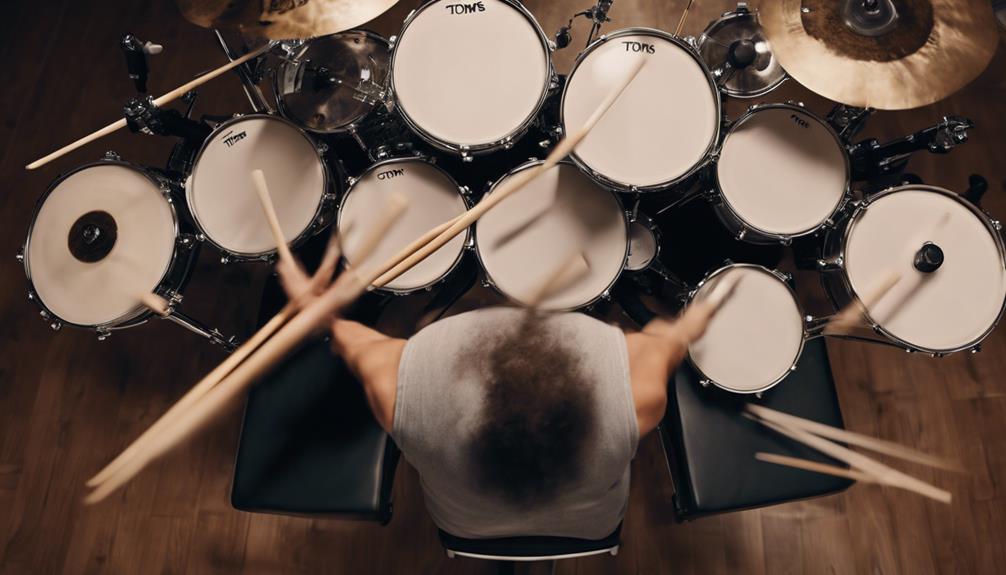When you’re starting out with drum fills, you might feel overwhelmed by the sheer number of techniques and patterns available. Focusing on the basics, like the traditional 8th note fill, can help you build a strong foundation. You’ll find that mastering timing, stick grip, and incorporating these fills into your drumming patterns is essential. But what makes these basic fills so indispensable for beginners? And how do they pave the way for more advanced techniques? Let’s break it down step by step and see how you can elevate your drumming skills from the ground up.
TL-DR
- Start with traditional 8th note fills to build a strong foundation.
- Practice basic stick techniques focusing on grip, timing, and rhythm.
- Incorporate simple fills into rock drumming patterns for practical application.
- Use a metronome to develop speed and control while practicing.
- Experiment with ending fills on a crash cymbal for smooth transitions.
What Is a Drum Fill?

A drum fill is a brief pattern that breaks away from a song’s main groove to create a shift between sections. You’ll notice that drum fills can vary in length, ranging from full bars to shorter durations like half or quarter bars. These fills serve as a musical bridge, adding excitement and dynamics by breaking up repetitive patterns and injecting some flair into the drumming.
When you’re playing a drum fill, you’re not just following a set rhythm; you’re exploring different drum voices and rhythms to enhance the overall musical experience. This can involve simple patterns or more complex sequences, depending on what the song demands. Often, a drum fill ends with a crash cymbal, signaling a smooth shift back to the main groove.
One of the best things about drum fills is their versatility. You can use them to build anticipation before a chorus, create a dramatic pause, or even just add a bit of your own personality to the music. By learning how to effectively use drum fills, you’ll be able to keep your drumming fresh and engaging, making each performance unique and memorable.
Importance of Drum Fills
In addition to adding excitement and dynamics, drum fills play a crucial role in maintaining the flow and progression of a song. When you use drum fills, you’re not just breaking up the main groove; you’re creating smooth connections between different sections. This keeps the music engaging and prevents it from becoming monotonous.
Drum fills also give you the chance to showcase your creativity and musicality. By adding your personal touch, you can turn a standard performance into something truly memorable. Listeners appreciate the variation and interest that drum fills bring to the music, which helps to keep them engaged.
Moreover, drum fills are essential tools for enhancing the overall feel and flow of a song. They provide context and build anticipation, guiding the listener through the musical journey. When you master drum fills, you’re not only improving your skills and coordination but also your ability to adapt to different musical styles. This versatility can make you a more proficient and sought-after drummer.
The Traditional 8th Note Fill

When practicing the traditional 8th note fill, focus on your basic stick techniques to make sure each note is clear and consistent.
Pay attention to your timing and rhythm, hitting each 8th note precisely to maintain the groove.
Incorporate practical practice tips, like starting slow and gradually increasing speed, to master this fill and improve your overall drumming skills.
Basic Stick Techniques
Mastering the traditional 8th note fill will lay the groundwork for adding exciting dynamics to your drumming. This common drum fill pattern is often the first that beginners learn, and for good reason. It’s simple yet effective, typically spanning a full measure and starting on the 1 count. By incorporating this fill into your basic rock drumming patterns, you’ll quickly see how it adds variation and keeps your playing fresh.
To get started, focus on your basic stick techniques. Hold your drumsticks comfortably, ensuring your grip allows for fluid wrist motion. Begin by playing steady 8th notes on the snare drum. Keep a consistent rhythm and volume, making sure each stroke is even. Practice alternating hands—right, left, right, left—to build coordination and speed.
Timing and Rhythm
To improve your drumming skills, start by mastering the timing and rhythm of the traditional 8th note fill. This fill is a staple for beginners and helps you develop a solid sense of timing. Typically, the 8th note fill spans a full measure and kicks off on the 1 beat. It’s straightforward and can be played across various drums.
Begin by focusing on the snare drum. Count each beat—1, 2, 3, 4—and play two notes per beat, making sure they’re evenly spaced. Practice this slowly at first. As you get comfortable, gradually increase your speed. Consistency is key, so make sure each note is crisp and clear.
Don’t forget, it’s essential to end the fill with a crash cymbal. This serves as a signal to seamlessly shift back into the main groove. The crash helps emphasize the end of the fill, making it clear and impactful.
Practical Practice Tips
Start by setting a metronome to a slow tempo to ensure you maintain consistent timing while practicing the traditional 8th note fill. This is essential for developing your sense of timing and coordination between your hands and feet.
Begin by playing the fill on the snare drum, starting on the 1 beat and continuing for a full measure.
Once you’re comfortable with this, try incorporating the toms and bass drum. For instance, you can alternate between the snare and toms while keeping the bass drum on the quarter notes. This variation helps you get used to moving around the kit while maintaining the steady 8th note pattern.
Remember, the traditional 8th note fill is versatile and can be adapted to different musical styles. Play it in various contexts, like rock, pop, or jazz, to understand its adaptability. Experiment with dynamics by playing some notes softer and others louder to add musical expression.
Regular practice of this foundational drum fill will set the stage for learning more complex patterns. Keep the metronome on, gradually increase the tempo, and stay patient. Consistent practice will improve your timing and fluidity, making your drum fills sound more polished and professional.
The 8th Note Build
When you use the 8th note build, you’ll focus on gradually increasing the volume by alternating hits on the snare and floor tom.
Keep your stick patterns simple to maintain control and consistency.
This technique not only heightens tension but also makes your progressions more exciting and impactful.
Gradual Volume Increase
Mastering the 8th note build can add a powerful tool to your drumming arsenal, allowing you to gradually increase volume and intensity. This technique typically involves alternating hits between the snare and the floor tom in a crescendo pattern. By doing so, you create a rising wave of sound that builds tension, leading into more energetic sections of a song or even complete stops.
To execute this effectively, start by playing steady 8th notes on the floor tom. Keep your strokes consistent and even. Gradually, introduce the snare drum, alternating hits between the snare and floor tom. As you continue, increase the force behind each hit, making the volume rise steadily. This gradual volume increase is key to creating a dynamic and exciting buildup.
Practice is essential. Begin slowly to make sure that each hit is clean and precise. As you become more comfortable, gradually increase your speed while maintaining control over the volume. This will help you develop the ability to create impactful progressions in your playing.
The 8th note build isn’t just about speed, but about control and dynamics, making it an invaluable skill for any drummer looking to add excitement and energy to their performances.
Simple Stick Patterns
Ever wondered how to make your drum fills sound more dynamic and engaging? The 8th note build is a perfect technique for beginners to master. This simple stick pattern involves alternating between your snare and floor tom, creating a crescendo that adds both tension and energy to your fills.
To start, play steady 8th notes on the snare. As you get comfortable, gradually bring in the floor tom, alternating hits between the two drums. Focus on a smooth increase in volume and intensity. This build-up helps shift into dynamic sections or stops in a song, making it a staple in rock music, though it’s versatile enough for other styles too.
Practicing the 8th note build is excellent for honing your timing, control, and dynamics. Begin at a slow tempo to guarantee accuracy before gradually speeding up. Remember, the key is consistency and smooth shifts between the snare and floor tom.
The Splat-Boom Fill

The splat-boom fill is an essential and straightforward pattern alternating between the snare and kick drum, perfect for adding energy to your rock drumming. Often used in rock music, this fill typically consists of either 8th or 16th notes and includes a flam on the snare drum. The flam adds a bit of flair, making the fill really pop. As you integrate this pattern, you’ll notice how it injects drive and excitement into your playing, a key aspect of rock music.
For beginners, the splat-boom fill is an excellent starting point to incorporate the bass drum into your fills. Begin by practicing the basic pattern: a flam on the snare followed by a kick drum hit. Repeat this sequence, ensuring your timing and coordination are spot-on. Start slow to get comfortable with the rhythm, then gradually increase your speed as you gain confidence.
The Traditional 16th Note Fill
When you start with the traditional 16th note fill, focus on the basic fill structure to build a solid foundation.
Pay attention to your hand-foot coordination to guarantee smooth shifts across the drum kit.
Experiment with tempo and dynamics to add excitement and variety to your fills.
Basic Fill Structure
Mastering the traditional 16th note fill, a versatile and foundational drum pattern, will greatly enhance your drumming skills and adaptability across various music styles. This fill consists of playing four notes per beat, creating a dynamic and intricate sound.
To start, use the tom toms to explore different sounds and textures. Here’s a simple way to break down the basic fill structure:
- Count the Beats: Begin by counting 1-e-&-a for each beat. This helps you stay in time and guarantees each note is evenly spaced.
- Start Slow: Practice the fill slowly on your snare drum, paying attention to even spacing. Gradually increase the tempo as you become more comfortable.
- Incorporate the Toms: Move your hands between the snare and tom toms. For example, play the first note on the snare, the second on the high tom, the third on the mid tom, and the fourth on the low tom.
- Experiment with Dynamics: Add accents on different notes to create variety and interest. This can make your fills sound more musical and expressive.
Hand-Foot Coordination
Enhancing your hand-foot coordination is essential for mastering the traditional 16th note fill and bringing your drumming to the next level. The traditional 16th note fill, a staple in various music styles, involves playing four evenly spaced notes per beat. This structure allows you to create intricate and dynamic patterns that can elevate any performance.
To start, focus on coordinating your hands and feet to make sure each note is played with precision. Begin by practicing simple hand-foot combinations, such as alternating between your snare drum and bass drum. Gradually increase the complexity by incorporating accents and ghost notes, which add depth and texture to the fill.
As you become more comfortable, you can orchestrate the 16th note fill around your drum kit. Experiment with different drums and cymbals to produce a unique sound. This practice not only enhances your hand-foot coordination but also improves your overall drumming skills.
Consistent practice with the traditional 16th note fill will lead to smoother progressions and tighter rhythms. Remember, the key to mastering this fill is patience and persistence. Keep working on your hand-foot coordination, and you’ll find yourself executing this versatile fill effortlessly.
Tempo and Dynamics
Building on your hand-foot coordination, let’s explore how tempo and dynamics play a critical role in executing the traditional 16th note fill effectively. This fill, made up of rapid 16th notes, demands precise control and attention to both speed and volume. Mastering it can transform a basic shift into a powerful musical statement.
First, let’s consider tempo. Practicing at various speeds helps you maintain consistency and adaptability. Start slow and gradually increase your speed, making sure each note is evenly spaced. Using a metronome can be invaluable here.
Next, dynamics are essential. Varying the loudness of your strokes can add texture and emotion to your fill. For instance, accenting specific notes can make certain beats stand out, creating a more compelling fill.
To seamlessly incorporate the 16th note fill into your playing:
- Begin with a quarter note pulse: This helps you stay in time and build a solid foundation.
- Increase your speed gradually: Start at a comfortable tempo and work up to faster speeds.
- Focus on even strokes: Make sure each note is played with the same intensity unless intentionally accenting.
- Experiment with accents: Highlight different parts of the fill to create variation and interest.
Pat Boone Debby Boone

One of the first drum fills beginners should learn is the Pat Boone Debby Boone, a classic and versatile pattern that fits seamlessly into various music styles. This fill is orchestrated with the rhythm pattern ‘pat-boone-de-bby-boone’ or 3 AND 4-E-AND. It’s commonly played as a 16th note fill, providing a smooth shift between song sections.
When you play the Pat Boone Debby Boone fill, you’ll notice its adaptability. Whether you’re jamming to rock, pop, or jazz, this fill enhances your drumming with a professional touch. Start by focusing on the timing and coordination. The pattern helps you lock in with the tempo, making your shifts smoother and more fluid.
To practice, break down the fill into smaller sections. Play the ‘pat-boone’ part first, then add the ‘de-bby-boone’. Combine them slowly, ensuring each stroke is even and precise. Once you’re comfortable, try speeding up gradually.
Mastering this fill won’t only improve your timing but also boost your creativity. You’ll find multiple ways to incorporate it into your playing, making it a valuable addition to your drumming toolkit.
The Motown Fill
Now that you’ve got the Pat Boone Debby Boone fill under your belt, let’s explore the Motown fill, a staple in blues and R&B drumming. This fill brings a soulful groove to your playing and typically involves orchestrating between the rack tom, snare drum, and floor tom. It’s usually played in 16th notes, giving it a flowing, rhythmic feel.
To master the Motown fill, follow these steps:
- Start with the rack tom: Begin by hitting the rack tom with your stick, setting the initial tone.
- Proceed to the snare: Progress to the snare drum, maintaining the 16th note pattern. This adds a crisp backbeat.
- Incorporate the floor tom: Add the floor tom to deepen the fill, giving it a fuller sound.
- Experiment with accents: Play around with variations and accents. This can add your unique flair and keep the fill from sounding monotonous.
Practicing the Motown fill will enhance your drumming repertoire and add flair to your playing style. Remember, the key is to keep the groove consistent and soulful. So, grab your sticks, and start experimenting with this iconic fill.
The Bucket of Fish Fill

When you want to infuse your drumming with energy and excitement, the Bucket of Fish fill is a fantastic tool to have in your arsenal. This rhythmic pattern is commonly used in rock music and instantly grabs attention. It consists of playing a 16th note triplet followed by an accent on the next 8th note. The result is a burst of rapid notes that seamlessly shifts back into your main drum beat.
To add even more flair, you can play a flam on the snare drum. This technique involves hitting the snare with both sticks almost simultaneously, creating a fuller sound. When executed correctly, the flam enhances the fill’s dynamic quality, making it sound powerful and professional.
Drummer Stephen Taylor demonstrates the Bucket of Fish fill in a video tutorial, making it easier for you to grasp the nuances of this exciting pattern. Once mastered, you’ll find it provides a fun and dynamic way to add bursts of energy to your drum fills.
Practice it slowly at first, ensuring each note is clear and accurate before incorporating it into your regular drum beat. With time, the Bucket of Fish fill will become a go-to element in your drumming repertoire.
Building Speed and Control
To build speed and control in your drum fills, start by practicing basic patterns at a slow tempo to develop muscle memory and accuracy. Focus on sticking patterns and hand coordination to improve your speed and precision.
Here’s how you can enhance your drum fills effectively:
- Start Slow: Begin with simple fills at a reduced tempo. This helps in internalizing the movements and guarantees each stroke is clean and accurate. The key is patience and repetition.
- Gradual Increase: Once you’re comfortable with the patterns, slowly increase the tempo. Use a metronome to track your progress and make sure you’re staying in time. This gradual increase challenges your muscle memory and enhances control.
- Experiment with Orchestrations: Don’t get stuck in a rut. Try different orchestrations around the kit. Move the same fill between toms, snare, and even cymbals to develop versatility and a unique style.
- End with Impact: Incorporate crashes at the end of your fills. This not only marks changes but also adds dramatic flair to your playing. It’s a small touch that makes a big difference.
Practicing Odd Groupings

Practicing odd groupings like threes, fives, and sevens can greatly enhance your creativity and complexity in drum fills. These groupings push you to think outside the box and break free from the typical even-numbered patterns. Start by playing groups of three, five, and seven as 16th notes to challenge your rhythmic abilities. This won’t only improve your drumming skills but also make your fills sound more dynamic and interesting.
Experiment by leading with your left hand for double-note hits on different toms. This approach can create a unique sound and make your fills stand out. As you become comfortable with these odd groupings, try moving your fills around the drum kit. This exploration helps you discover new sounds and textures, adding depth to your playing.
Remember to resolve your fills with crashes. This technique marks the shift back into the main groove, ensuring your fills flow seamlessly with the rest of the song. By incorporating odd groupings into your practice routine, you’ll develop greater control, speed, and creativity, making your drum fills more engaging and impressive.
Keep practicing, and you’ll notice a significant improvement in your overall drumming.
Tips for Creative Fills
Building on your newfound skills with odd groupings, let’s explore some tips for creating more dynamic and interesting drum fills. As you play drums, these strategies will help you craft fills that stand out and enhance your overall performance.
- Experiment with Sticking Patterns:
Mixing up your sticking patterns like RLRL (right-left-right-left) or RLLR (right-left-left-right) can bring a fresh feel to your fills. These variations can lead to unexpected rhythmic textures and keep your playing from becoming monotonous.
- Incorporate Ghost Notes:
Adding ghost notes—those subtle, quieter hits—within your fills can add depth and dynamics to your drumming. These notes fill in the gaps and create a richer, more complex sound.
- Use Accents:
Placing accents on certain notes within your fill can emphasize key beats and drive the rhythm forward. Accents can make your fills more engaging and help them stand out within the context of a song.
- Smooth Transitions:
Practice moving smoothly from your main groove into your fills and back again. This ensures that your fills enhance the song’s momentum without disrupting the flow.
Don’t be afraid to make mistakes. Experiment with different combinations to find your unique style and sound as you play drums.
Next up, learn about how to develop limb independence for drumming in this guide.
